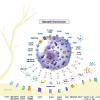Basophils in pruritic skin diseases
- PMID: 37465674
- PMCID: PMC10350488
- DOI: 10.3389/fimmu.2023.1213138
Basophils in pruritic skin diseases
Abstract
Basophils are rare cells in the peripheral blood which have the capability to infiltrate into the skin. Invasion of basophils has been detected in pruritic skin diseases, including atopic dermatitis, bullous pemphigoid, chronic spontaneous urticaria and contact dermatitis. In the skin, basophils are important players of the inflammatory immune response, as they release Th2 cytokines, including interleukin (IL)-4 and IL-13, subsequently inducing the early activation of T-cells. Further, basophils release a multitude of mediators, such as histamine and IL-31, which both play an important role in the initiation of the pruritic response via activation of sensory nerves. Chronic pruritus significantly affects the quality of life and the working capability of patients, though its mechanisms are not fully elucidated yet. Since basophils and neurons share many receptors and channels, bidirectional interaction mechanisms, which drive the sensation of itch, are highlighted in this review.
Keywords: IL-31; atopic dermatitis; basophils; neuro-immune interaction; pruritus.
Copyright © 2023 Wiebe, Limberg, Gray and Raap.
Conflict of interest statement
The authors declare that the research was conducted in the absence of any commercial or financial relationships that could be construed as a potential conflict of interest.
Figures

References
-
- Ehrlich P. Beiträge zur kenntnis der granulirten bindegewebszellen und der eosinophilen leukoythen. Arch Anat Physiol (Leizig) (1879) 3:166.
Publication types
MeSH terms
LinkOut - more resources
Full Text Sources
Medical
Research Materials

